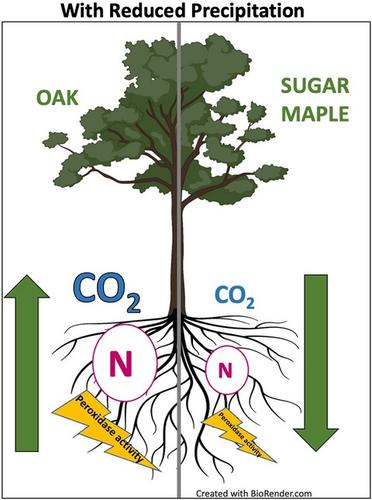当前位置:
X-MOL 学术
›
Glob. Change Biol.
›
论文详情
Our official English website, www.x-mol.net, welcomes your
feedback! (Note: you will need to create a separate account there.)
Plant–microbial responses to reduced precipitation depend on tree species in a temperate forest
Global Change Biology ( IF 10.8 ) Pub Date : 2022-07-14 , DOI: 10.1111/gcb.16340 Nanette C Raczka 1 , Joseph E Carrara 1 , Edward R Brzostek 1
Global Change Biology ( IF 10.8 ) Pub Date : 2022-07-14 , DOI: 10.1111/gcb.16340 Nanette C Raczka 1 , Joseph E Carrara 1 , Edward R Brzostek 1
Affiliation

|
Given that global change is predicted to increase the frequency and severity of drought in temperate forests, it is critical to understand the degree to which plant belowground responses cascade through the soil system to drive ecosystem responses to water stress. While most research has focused on plant and microbial responses independently of each other, a gap in our understanding lies in the integrated response of plant-microbial interactions to water stress. We investigated the extent to which divergent belowground responses to reduced precipitation between sugar maple trees (Acer saccharum) versus oak trees (Oak spp.) may influence microbial activity via throughfall exclusion in the field. Evidence that oak trees send carbon belowground to prime microbial activity more than maples under ambient conditions and in response to water stress suggests there is the potential for corresponding impacts of reduced precipitation on microbial activity. As such, we tested the hypothesis that differences in belowground C allocation between oaks and maples would stimulate microbial activity in the oak treatment soils and reduce microbial activity in in the sugar maple treatment soils compared to their respective controls. We found that the treatment led to declines in N mineralization, soil respiration, and oxidative enzyme activity in the sugar maple treatment plot. These declines may be due to sugar maple trees reducing root C transfers to the soil. By contrast, the reduced precipitation treatment enhanced soil respiration, as well as rates of N mineralization and peroxidase activity in the oak rhizosphere. This enhanced activity suggests that oak roots provided optimal rhizosphere conditions during water stress to prime microbial activity to support net primary production. With future changes in precipitation predicted for forests in the Eastern US, we show that the strength of plant-microbial interactions drives the degree to which reduced precipitation impacts soil C and nutrient cycling.
中文翻译:

植物-微生物对降水减少的反应取决于温带森林中的树种
鉴于全球变化预计会增加温带森林干旱的频率和严重程度,因此了解植物地下响应通过土壤系统级联以驱动生态系统对水分胁迫的响应的程度至关重要。虽然大多数研究都专注于相互独立的植物和微生物反应,但我们理解的差距在于植物-微生物相互作用对水分胁迫的综合反应。我们调查了糖枫树 ( Acer saccharum ) 与橡树 ( Oakspp.) 可能会通过田间的穿透排除影响微生物活动。有证据表明,在环境条件下,橡树比枫树更能将地下碳释放到主要的微生物活动中,并且对水分胁迫的反应表明,降水减少可能会对微生物活动产生相应的影响。因此,我们检验了这样一个假设,即与各自的对照相比,橡树和枫树之间地下 C 分配的差异会刺激橡树处理土壤中的微生物活性并降低糖枫处理土壤中的微生物活性。我们发现该处理导致糖枫处理地块中氮矿化、土壤呼吸和氧化酶活性下降。这些下降可能是由于糖槭树减少了根 C 向土壤的转移。相比之下,减少的降水处理增强了土壤呼吸,以及橡木根际氮矿化和过氧化物酶活性的速率。这种增强的活性表明,橡树根在水分胁迫期间提供了最佳的根际条件,以启动微生物活动以支持净初级生产。随着预测美国东部森林的未来降水变化,我们表明植物-微生物相互作用的强度推动了降水减少对土壤碳和养分循环的影响程度。
更新日期:2022-07-14
中文翻译:

植物-微生物对降水减少的反应取决于温带森林中的树种
鉴于全球变化预计会增加温带森林干旱的频率和严重程度,因此了解植物地下响应通过土壤系统级联以驱动生态系统对水分胁迫的响应的程度至关重要。虽然大多数研究都专注于相互独立的植物和微生物反应,但我们理解的差距在于植物-微生物相互作用对水分胁迫的综合反应。我们调查了糖枫树 ( Acer saccharum ) 与橡树 ( Oakspp.) 可能会通过田间的穿透排除影响微生物活动。有证据表明,在环境条件下,橡树比枫树更能将地下碳释放到主要的微生物活动中,并且对水分胁迫的反应表明,降水减少可能会对微生物活动产生相应的影响。因此,我们检验了这样一个假设,即与各自的对照相比,橡树和枫树之间地下 C 分配的差异会刺激橡树处理土壤中的微生物活性并降低糖枫处理土壤中的微生物活性。我们发现该处理导致糖枫处理地块中氮矿化、土壤呼吸和氧化酶活性下降。这些下降可能是由于糖槭树减少了根 C 向土壤的转移。相比之下,减少的降水处理增强了土壤呼吸,以及橡木根际氮矿化和过氧化物酶活性的速率。这种增强的活性表明,橡树根在水分胁迫期间提供了最佳的根际条件,以启动微生物活动以支持净初级生产。随着预测美国东部森林的未来降水变化,我们表明植物-微生物相互作用的强度推动了降水减少对土壤碳和养分循环的影响程度。











































 京公网安备 11010802027423号
京公网安备 11010802027423号